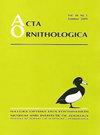保加利亚南部俾格米Cormorant Microcarbo pygmaeus越冬种群的长期变化
IF 0.8
4区 生物学
Q3 ORNITHOLOGY
引用次数: 0
摘要
摘要由于不同的威胁影响了水鸟的数量,并改变了它们的繁殖和越冬范围,水鸟在全球范围内正在减少。冬季,珊瑚虫分散在很远的地方,是人类与野生动物相互作用和非生物因素影响的合适指标。在越冬期间,侏儒Cormorants Microcarbo pygmaeus使用常规栖息地,在合适的栖息处过夜,这是一个躲避恶劣天气条件和干扰的避难所。我们的研究旨在确定保加利亚南部Maritsa河谷七个栖息地的俾格米Cormorant越冬种群规模及其23年(1996-2019)的动态。这是物种保护的关键地点,每年有3065–8180只鸟类在这里过冬。1996年至2019年间,越冬的俾格米Cormorant种群呈增加趋势(λ=1.03±0.001)。每年12月,俾格米Cormorant数量最多(平均值±SE,2609±185只),而3月的数量最低(1207±106只)。在整个研究过程中,侏儒Cormorants在下午4:00至5:30之间聚集栖息。在研究期间,所有栖息地的俾格米Cormorant越冬觅食栖息地面积从2675.97公顷显著增加到22564.35公顷。每天平均气温的下降和白天长度的减少对栖息的俾格米Cormorant的数量产生了积极影响。尽管全球种群数量在增加,但俾格米Cormorant在越冬期间面临着人类死亡的高风险,因此被区域归类为濒危物种。本文章由计算机程序翻译,如有差异,请以英文原文为准。
Long-Term Changes in a Pygmy Cormorant Microcarbo pygmaeus Wintering Population in Southern Bulgaria
Abstract. Waterbirds are declining globally due to different threats that affect their abundance and shift both their breeding and wintering ranges. Cormorants disperse over vast distances during winter and are suitable indicators of the impacts of human-wildlife interactions and abiotic factors. During wintering periods, Pygmy Cormorants Microcarbo pygmaeus use regular roosts where they overnight on suitable perches, a refuge from adverse weather conditions and disturbances. Our study aimed to determine the wintering population size of the Pygmy Cormorant and its dynamics across 23-years (1996–2019) at seven roosting sites in the Maritsa River valley, Southern Bulgaria. This is a critical site for the species conservation where 3065–8180 birds are wintering annually. The wintering Pygmy Cormorant population showed a tendency to increase between 1996 and 2019 (λ = 1.03 ± 0.001). Each year Pygmy Cormorants were most abundant in December (mean ± SE, 2609 ± 185 individuals), while the lowest numbers were recorded in March (1207 ± 106). Pygmy Cormorants aggregated to roost between 4:00 PM and 5:30 PM throughout the study. The area of wintering foraging habitat of the Pygmy Cormorant increased significantly across all roosting sites in the study period from 2675.97 ha to 22564.35 ha. The number of Pygmy Cormorants at the roost was positively affected by the drop in the daily air mean temperatures and the decrease of the day length. Despite the global population increase, the Pygmy Cormorant faces a high risk of human-induced mortality during wintering and is thus regionally classified as endangered.
求助全文
通过发布文献求助,成功后即可免费获取论文全文。
去求助
来源期刊

Acta Ornithologica
生物-鸟类学
CiteScore
2.10
自引率
0.00%
发文量
14
审稿时长
>12 weeks
期刊介绍:
Publishes scientific papers (original research reports, reviews, short notes, etc.) and announcements from all fields of ornithology. All manuscripts are peer-reviewed.
Established in 1933 as Acta Ornithologica Musei Zoologici Polonici, since 1953 continued under the present title.
Published twice a year by the Natura Optima Dux Foundation under the auspices of the Museum and Institute of Zoology, Polish Academy of Sciences.
 求助内容:
求助内容: 应助结果提醒方式:
应助结果提醒方式:


